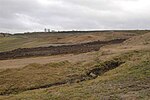Hainworth
Geography of the City of BradfordKeighleyUse British English from July 2019Villages in West Yorkshire

Hainworth is a hamlet 1 mile (2 km) south of Keighley in West Yorkshire, England. The hamlet faces north across the lower end of the Worth Valley with a steep wooded incline towards Keighley.
Excerpt from the Wikipedia article Hainworth (License: CC BY-SA 3.0, Authors, Images).Hainworth
Goff Well Lane, Bradford
Geographical coordinates (GPS) Address Nearby Places Show on map
Geographical coordinates (GPS)
| Latitude | Longitude |
|---|---|
| N 53.8483 ° | E -1.9105 ° |
Address
Goff Well Lane
Goff Well Lane
BD21 5QG Bradford
England, United Kingdom
Open on Google Maps










